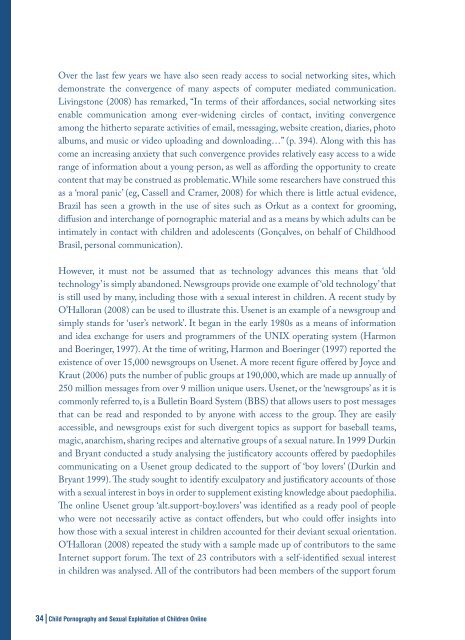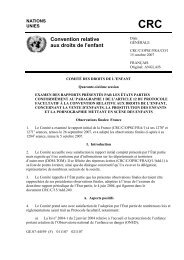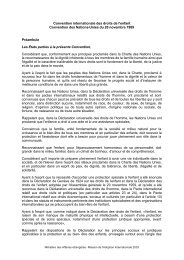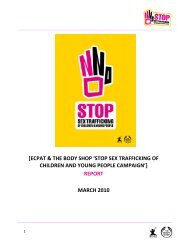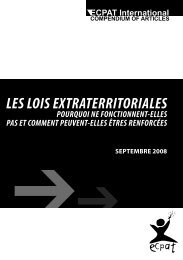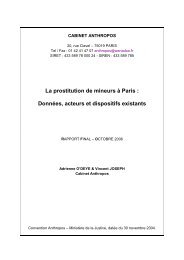child pornography and sexual exploitation of children online
child pornography and sexual exploitation of children online
child pornography and sexual exploitation of children online
You also want an ePaper? Increase the reach of your titles
YUMPU automatically turns print PDFs into web optimized ePapers that Google loves.
Over the last few years we have also seen ready access to social networking sites, which<br />
demonstrate the convergence <strong>of</strong> many aspects <strong>of</strong> computer mediated communication.<br />
Livingstone (2008) has remarked, “In terms <strong>of</strong> their affordances, social networking sites<br />
enable communication among ever-widening circles <strong>of</strong> contact, inviting convergence<br />
among the hitherto separate activities <strong>of</strong> email, messaging, website creation, diaries, photo<br />
albums, <strong>and</strong> music or video uploading <strong>and</strong> downloading…” (p. 394). Along with this has<br />
come an increasing anxiety that such convergence provides relatively easy access to a wide<br />
range <strong>of</strong> information about a young person, as well as affording the opportunity to create<br />
content that may be construed as problematic. While some researchers have construed this<br />
as a ‘moral panic’ (eg, Cassell <strong>and</strong> Cramer, 2008) for which there is little actual evidence,<br />
Brazil has seen a growth in the use <strong>of</strong> sites such as Orkut as a context for grooming,<br />
diffusion <strong>and</strong> interchange <strong>of</strong> pornographic material <strong>and</strong> as a means by which adults can be<br />
intimately in contact with <strong>child</strong>ren <strong>and</strong> adolescents (Gonçalves, on behalf <strong>of</strong> Childhood<br />
Brasil, personal communication).<br />
However, it must not be assumed that as technology advances this means that ‘old<br />
technology’ is simply ab<strong>and</strong>oned. Newsgroups provide one example <strong>of</strong> ‘old technology’ that<br />
is still used by many, including those with a <strong>sexual</strong> interest in <strong>child</strong>ren. A recent study by<br />
O’Halloran (2008) can be used to illustrate this. Usenet is an example <strong>of</strong> a newsgroup <strong>and</strong><br />
simply st<strong>and</strong>s for ‘user’s network’. It began in the early 1980s as a means <strong>of</strong> information<br />
<strong>and</strong> idea exchange for users <strong>and</strong> programmers <strong>of</strong> the UNIX operating system (Harmon<br />
<strong>and</strong> Boeringer, 1997). At the time <strong>of</strong> writing, Harmon <strong>and</strong> Boeringer (1997) reported the<br />
existence <strong>of</strong> over 15,000 newsgroups on Usenet. A more recent figure <strong>of</strong>fered by Joyce <strong>and</strong><br />
Kraut (2006) puts the number <strong>of</strong> public groups at 190,000, which are made up annually <strong>of</strong><br />
250 million messages from over 9 million unique users. Usenet, or the ‘newsgroups’ as it is<br />
commonly referred to, is a Bulletin Board System (BBS) that allows users to post messages<br />
that can be read <strong>and</strong> responded to by anyone with access to the group. They are easily<br />
accessible, <strong>and</strong> newsgroups exist for such divergent topics as support for baseball teams,<br />
magic, anarchism, sharing recipes <strong>and</strong> alternative groups <strong>of</strong> a <strong>sexual</strong> nature. In 1999 Durkin<br />
<strong>and</strong> Bryant conducted a study analysing the justificatory accounts <strong>of</strong>fered by paedophiles<br />
communicating on a Usenet group dedicated to the support <strong>of</strong> ‘boy lovers’ (Durkin <strong>and</strong><br />
Bryant 1999). The study sought to identify exculpatory <strong>and</strong> justificatory accounts <strong>of</strong> those<br />
with a <strong>sexual</strong> interest in boys in order to supplement existing knowledge about paedophilia.<br />
The <strong>online</strong> Usenet group ‘alt.support-boy.lovers’ was identified as a ready pool <strong>of</strong> people<br />
who were not necessarily active as contact <strong>of</strong>fenders, but who could <strong>of</strong>fer insights into<br />
how those with a <strong>sexual</strong> interest in <strong>child</strong>ren accounted for their deviant <strong>sexual</strong> orientation.<br />
O’Halloran (2008) repeated the study with a sample made up <strong>of</strong> contributors to the same<br />
Internet support forum. The text <strong>of</strong> 23 contributors with a self-identified <strong>sexual</strong> interest<br />
in <strong>child</strong>ren was analysed. All <strong>of</strong> the contributors had been members <strong>of</strong> the support forum<br />
34|Child Pornography <strong>and</strong> Sexual Exploitation <strong>of</strong> Children Online


